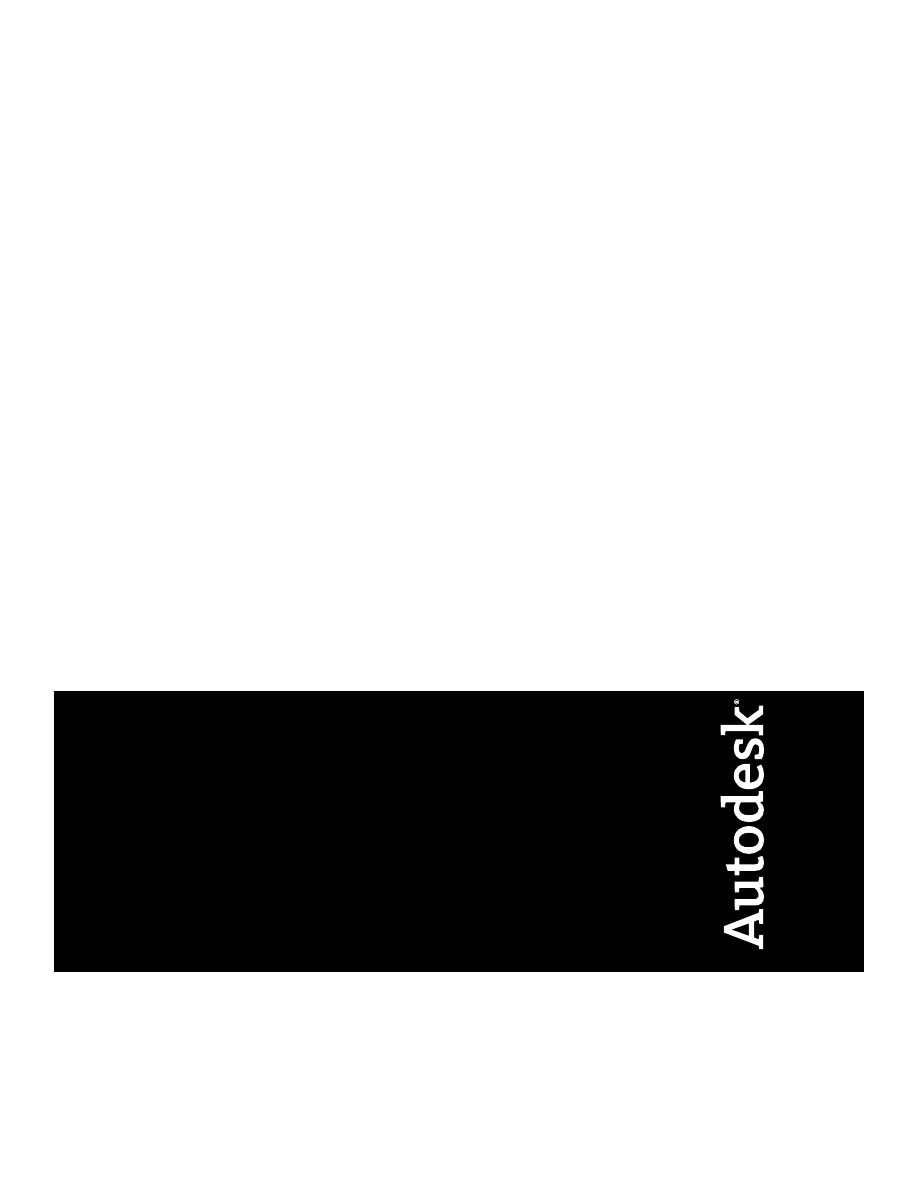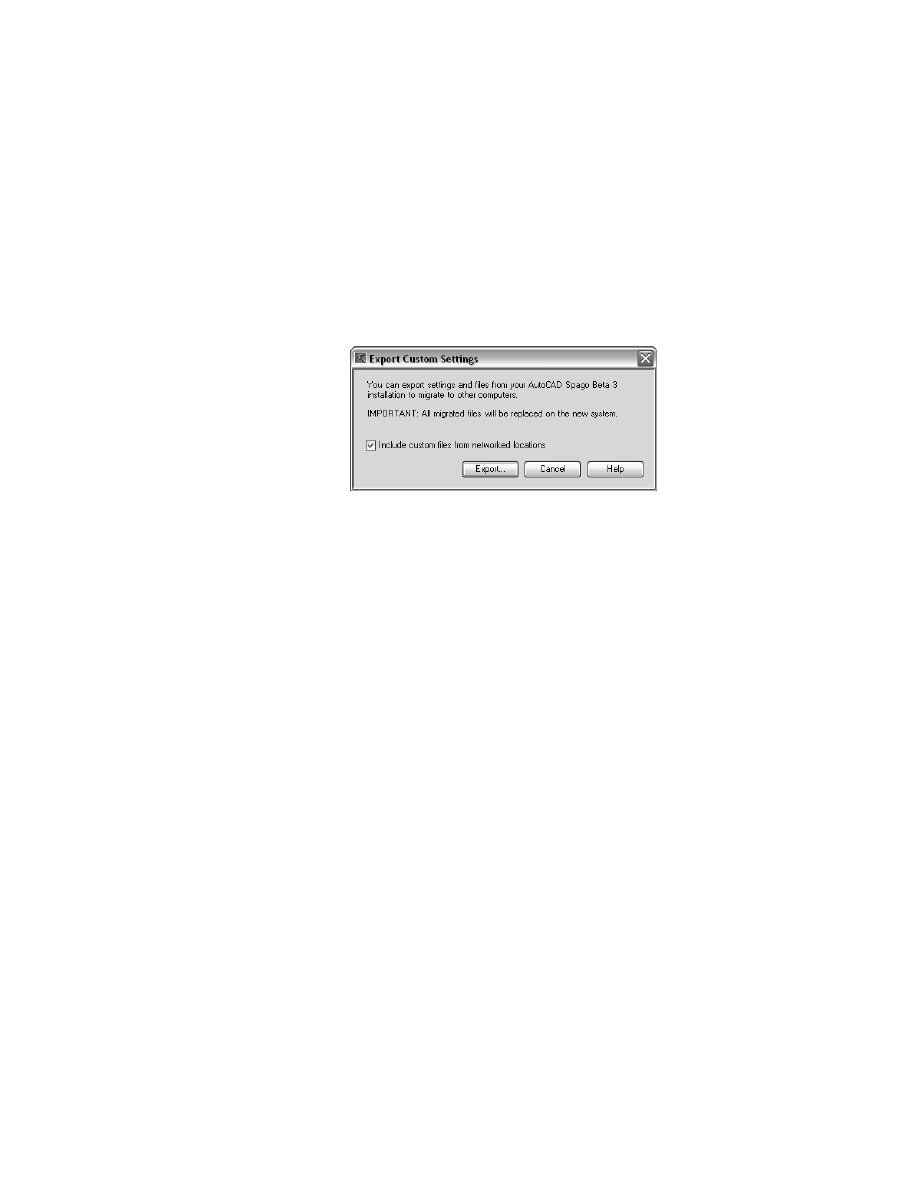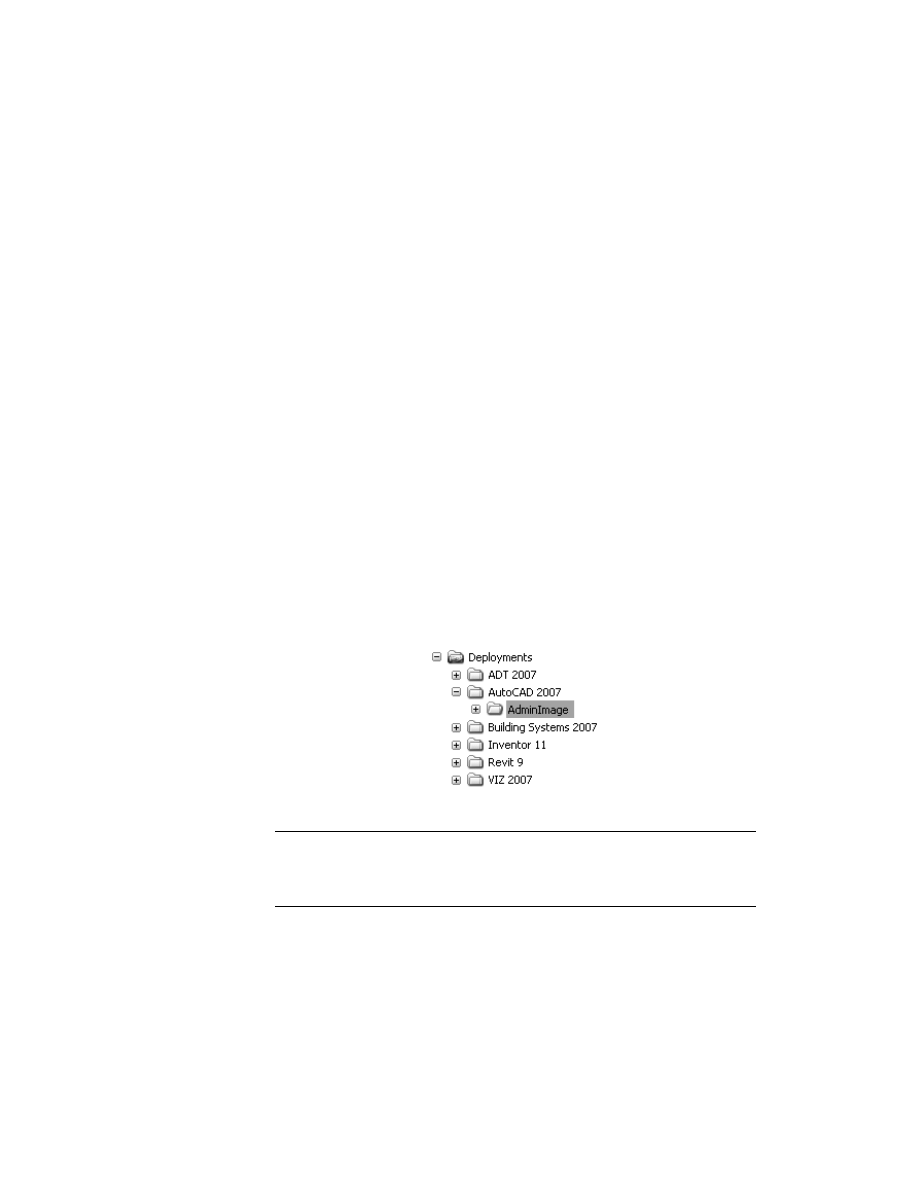
AutoCAD
®
2008
Stand-Alone Installation
Guide
January 2007

Copyright
©
2007 Autodesk, Inc.
All Rights Reserved
This publication, or parts thereof, may not be reproduced in any form, by any method, for any purpose.
AUTODESK, INC., MAKES NO WARRANTY, EITHER EXPRESS OR IMPLIED, INCLUDING BUT NOT LIMITED TO ANY IMPLIED
WARRANTIES OF MERCHANTABILITY OR FITNESS FOR A PARTICULAR PURPOSE REGARDING THESE MATERIALS, AND MAKES SUCH
MATERIALS AVAILABLE SOLELY ON AN "AS-IS" BASIS.
IN NO EVENT SHALL AUTODESK, INC., BE LIABLE TO ANYONE FOR SPECIAL, COLLATERAL, INCIDENTAL, OR CONSEQUENTIAL
DAMAGES IN CONNECTION WITH OR ARISING OUT OF ACQUISITION OR USE OF THESE MATERIALS. THE SOLE AND EXCLUSIVE
LIABILITY TO AUTODESK, INC., REGARDLESS OF THE FORM OF ACTION, SHALL NOT EXCEED THE PURCHASE PRICE, IF ANY, OF
THE MATERIALS DESCRIBED HEREIN.
Autodesk, Inc., reserves the right to revise and improve its products as it sees fit. This publication describes the state of the product at the time
of publication, and may not reflect the product at all times in the future.
Autodesk Trademarks
The following are registered trademarks or trademarks of Autodesk, Inc., in the USA and other countries: 3DEC (design/logo), 3December,
3December.com, 3ds Max, ActiveShapes, Actrix, ADI, Alias, Alias (swirl design/logo), AliasStudio, Alias|Wavefront (design/logo), ATC, AUGI,
AutoCAD, AutoCAD Learning Assistance, AutoCAD LT, AutoCAD Simulator, AutoCAD SQL Extension, AutoCAD SQL Interface, Autodesk, Autodesk
Envision, Autodesk Insight, Autodesk Intent, Autodesk Inventor, Autodesk Map, Autodesk MapGuide, Autodesk Streamline, AutoLISP, AutoSnap,
AutoSketch, AutoTrack, Backdraft, Built with ObjectARX (logo), Burn, Buzzsaw, CAiCE, Can You Imagine, Character Studio, Cinestream, Civil
3D, Cleaner, Cleaner Central, ClearScale, Colour Warper, Combustion, Communication Specification, Constructware, Content Explorer,
Create>what's>Next> (design/logo), Dancing Baby (image), DesignCenter, Design Doctor, Designer's Toolkit, DesignKids, DesignProf, DesignServer,
DesignStudio, Design|Studio (design/logo), Design Your World, Design Your World (design/logo), DWF, DWG, DWG (logo), DWG TrueConvert,
DWG TrueView, DXF, EditDV, Education by Design, Extending the Design Team, FBX, Filmbox, FMDesktop, GDX Driver, Gmax, Heads-up
Design, Heidi, HOOPS, HumanIK, i-drop, iMOUT, Incinerator, IntroDV, Kaydara, Kaydara (design/logo), LocationLogic, Lustre, Maya, Mechanical
Desktop, MotionBuilder, ObjectARX, ObjectDBX, Open Reality, PolarSnap, PortfolioWall, Powered with Autodesk Technology, Productstream,
ProjectPoint, Reactor, RealDWG, Real-time Roto, Render Queue, Revit, Showcase, SketchBook, StudioTools, Topobase, Toxik, Visual, Visual
Bridge, Visual Construction, Visual Drainage, Visual Hydro, Visual Landscape, Visual Roads, Visual Survey, Visual Syllabus, Visual Toolbox, Visual
Tugboat, Visual LISP, Voice Reality, Volo, and Wiretap.
The following are registered trademarks or trademarks of Autodesk Canada Co. in the USA and/or Canada and other countries: Backburner,
Discreet, Fire, Flame, Flint, Frost, Inferno, Multi-Master Editing, River, Smoke, Sparks, Stone, Wire.
Third Party Trademarks
All other brand names, product names or trademarks belong to their respective holders.
Third Party Software Program Credits
ACIS Copyright
©
1989-2001 Spatial Corp.
Copyright
©
1999-2000 The Apache Software Foundation. All rights reserved. This product includes software developed by the Apache Software
Foundation (http://www.apache.org) subject to its license terms and conditions (http://xml.apache.org/dist/LICENSE.txt).
Typefaces from the Bitstream
®
typeface library Copyright
©
1992.
HLM
©
Copyright D-Cubed Ltd. 1996-2006. HLM is a trademark of D-Cubed Ltd.
AutoCAD
®
2008 and AutoCAD LT
®
2008 are produced under a license of data derived from DIC Color Guide
®
from Dainippon Ink and Chemicals,
Inc. Copyright
©
Dainippon Ink and Chemicals, Inc. All rights reserved. DIC and DIC Color Guide are registered trademarks of Dainippon Ink
and Chemicals, Inc.
Portions of this software are based on the work of the Independent JPEG Group.
Active Delivery
™
2.0
©
1999-2004 Inner Media, Inc. All rights reserved.
ISYS and the ISYS logo are registered trademarks or trademarks of ISYS
®
Search Software Inc.
Copyright
©
1988-1997 Sam Leffler. Copyright
©
1991-1997 Silicon Graphics, Inc.
Copyright
©
Lingea s.r.o. 2006.
The New Features Workshop contains Macromedia Flash
™
Player software by Macromedia, Inc. Copyright
©
1995-2005 Macromedia, Inc. All
rights reserved. Macromedia
®
and Flash
®
are registered trademarks or trademarks of Adobe Systems Incorporated in the United States or other
countries.
Copyright
©
1996-2006 Macrovision Corporation. All rights reserved.
Copyright
©
1996-2006 Microsoft Corporation. All rights reserved.
Copyright
©
2002 Joseph M. O'Leary.
PANTONE
®
Colors displayed in the software application or in the user documentation may not match -PANTONE-identified standards. Consult
current PANTONE Color Publications for accurate color.
PANTONE
®
and other Pantone, Inc. trademarks are the property of Pantone, Inc.
©
Pantone, Inc., 2004.
Pantone, Inc. is the copyright owner of color data and/or software which are licensed to Autodesk, Inc., to distribute for use only in combination
with certain Autodesk software products. PANTONE Color Data and/or Software shall not be copied onto another disk or into memory unless
as part of the execution of this Autodesk software product.
Typefaces from Payne Loving Trust
©
1992, 1996. All rights reserved.
RAL DESIGN
©
RAL, Sankt Augustin, 2004.
RAL CLASSIC
©
RAL, Sankt Augustin, 2004.
Representation of the RAL Colors is done with the approval of RAL Deutsches Institut für Gütesicherung und Kennzeichnung e.V. (RAL German
Institute for Quality Assurance and Certification, re. Assoc.), D-53757 Sankt Augustin.

This product includes code licensed from RSA Security, Inc. Some portions licensed from IBM are available at http://oss.software.ibm.com/icu4j/.
The Sentry Spelling-Checker Engine Copyright
©
1994-2003 Wintertree Software, Inc.
Portions of this product include one or more Boost libraries. Use of the Boost libraries is subject to its license agreement
http://www.boost.org/LICENSE_1_0.txt.
GOVERNMENT USE
Use, duplication, or disclosure by the U.S. Government is subject to restrictions as set forth in FAR 12.212 (Commercial Computer
Software-Restricted Rights) and DFAR 227.7202 (Rights in Technical Data and Computer Software), as applicable.

1 2 3 4 5 6 7 8 9 10

Contents
Chapter 1
Quick Start to Stand-Alone Installation
How to Prepare for Installation
. . . . . . . . . . . . . . . . . . . . . . . 2
How to Review System Requirements
. . . . . . . . . . . . . . . . 2
How to Understand Administrative Permission
. . . . . . . . . . . . . . . . . . . . . . . . . . . . 2
How to Install Multiple or Bundled Products
How to Locate Your AutoCAD 2008 Serial Number
How to Avoid Data Loss During Installation
How to Migrate Custom Settings from Previous Versions
How to Install and Run AutoCAD
. . . . . . . . . . . . . . . . . . . . . 3
. . . . . . . . . . . . . . . . . . . . . . . 4
How to Register and Activate AutoCAD
. . . . . . . . . . . . . . . 4
. . . . . . . . . . . . . . . . . . . 4
How to Install and Start the CAD Manager Control Utility
How to install the CAD Manager Control utility
Chapter 2
Move to AutoCAD 2008 from a Previous or Same Release
Migrate Custom Settings and Files from Previous Releases
. . . . . . . . . . . . . . . . . . . . . . . 9
. . . . . . . . . . . . . . . . . 13
Restore AutoCAD 2008 Profiles After Migrating Files from
. . . . . . . . . . . . . . . . . . . . . . 13
. . . . . . . . . . . . . . . . . . . . . . . . . 14
v

Export and Import Custom Settings from the Same Release
. . . . . . . . . . . . . . . . . . . . . . . 17
. . . . . . . . . . . . . . . . . . . . . . . 18
. . . . . . . . . . . . . . . . . . . . . . . . . . 19
. . . . . . . . . . . . . . . . . . . . . . . . 20
. . . . . . . . . . . . . . . . . . . . . . . . 21
. . . . . . . . . . . . . . . . . . . . . . . . . 21
. . . . . . . . . . . . . . . . . . . . . . . . . 22
. . . . . . . . . . . . . . . . . . . . . . . . . 23
. . . . . . . . . . . . . . . . . . . 26
. . . . . . . . . . . . . . . . . . . . . . . . . 26
Chapter 3
Install Autodesk Products for an Individual User
The AutoCAD 2008 Installation Wizard
. . . . . . . . . . . . . . . . . 30
. . . . . . . . . . . . . . . . . . . . . . . . . . . 30
. . . . . . . . . . . . . . . . . . . . . . . . . . . . . . 33
. . . . . . . . . . . . . . . . . . . . . . 38
. . . . . . . . . . . . . . . . . . . . . . . . . . 39
. . . . . . . . . . . . . . . . . . . . . . . 40
. . . . . . . . . . . . . . . . . . . . . . . . . . . . 41
Chapter 4
. . . . . . . . . . . . . . . . . . . 43
. . . . . . . . . . . . . . . . . . . . . . . . 44
How can I check my graphics card driver to see if it needs to be
. . . . . . . . . . . . . . . . . . . . . . . . . . . . . . 44
What is the text editor used for?
. . . . . . . . . . . . . . . . . . 44
Can I change the default text editor later?
When performing a Typical installation, what gets
. . . . . . . . . . . . . . . . . . . . . . . . . . . . . 45
What is the advantage to installing the Materials Library?
. . . . . . . . . . . . . . . . . . 46
. . . . . . . . . . . . . . . . . . . . . . . . . . . . 47
Is there a checklist I can refer to when performing a
. . . . . . . . . . . . . . . . . . . . . . . . . . . . 47
Where should deployments be located?
. . . . . . . . . . . . . . 47
What are the default search paths and file location
. . . . . . . . . . . . . . . . . . . . . . . . . . . . . . 48
Along with defining search paths and file location, can files be
. . . . . . . . . . . . . . . . . . . . . . . . . . . . . . . 51
Where can I check if service packs are available for my
. . . . . . . . . . . . . . . . . . . . . . . . . . . . . . 51
. . . . . . . . . . . . . . . . . . . . 51
Can Online Resource settings be modified later?
Where can I learn about InfoCenter?
. . . . . . . . . . . . . . . . 52
What are Information Channels?
. . . . . . . . . . . . . . . . . . 52
vi | Contents

What are the benefits to enabling CAD Manager
. . . . . . . . . . . . . . . . . . . . . . . . . . . . . 52
What are RSS feeds and how do they benefit my
. . . . . . . . . . . . . . . . . . . . . . . . . . . . 53
Where can I learn about InfoCenter search locations?
How do I set or customize search locations?
. . . . . . . . . . . . . . . . . . . . . . . . . . . . . . 53
What is the difference between a stand-alone license and a
. . . . . . . . . . . . . . . . . . . . . . . . . . 54
What is the benefit to using a network licensed version of the
. . . . . . . . . . . . . . . . . . . . . . . . . . . . . . 54
What is Internet Explorer used for?
. . . . . . . . . . . . . . . . . 54
. . . . . . . . . . . . . . . . . . . . . . . . . . . . . 55
When installing tools and utilities, which selections are
applicable for a multi-seat stand-alone installation?
When installing tools and utilities, which selections are suitable
for a stand-alone installation?
. . . . . . . . . . . . . . . . . . 55
Where do I find my server name?
. . . . . . . . . . . . . . . . . 55
If I choose to create a log file, what kind of information does
. . . . . . . . . . . . . . . . . . . . . . . . 56
When specifying user workstation settings, I’m given the option
to specify a profile. What are profiles?
. . . . . . . . . . . . . . 56
Can I create custom desktop shortcuts?
. . . . . . . . . . . . . . 56
What happens when you choose to append or merge service
. . . . . . . . . . . . . . . . . . . . . . . . . . . . . . . 57
What is an administrative image (MSI) file?
Uninstall and Maintenance Issues
. . . . . . . . . . . . . . . . . . . . 57
When adding or removing features, how can I tell what features
. . . . . . . . . . . . . . . . . . . . . . 58
Is it possible to change the installation folder when adding or
. . . . . . . . . . . . . . . . . . . . . . . . 59
When should I reinstall the product instead of a repair?
Do I need my original disk to reinstall my software?
After repairing my installation, is it possible to recover my
. . . . . . . . . . . . . . . . . . . . . . . . . . . . . . 60
When I uninstall my software, what files are left on my
. . . . . . . . . . . . . . . . . . . . . . . . . . . . . . 60
. . . . . . . . . . . . . . . . . . . . . . . . . . . . . . . . 61
Contents | vii

viii

Quick Start to
Stand-Alone Installation
In this chapter
This section provides step-by-step instructions about how to
install AutoCAD on your system. You should read the entire
■
How to Prepare for
Installation
Stand-Alone Installation Guide if you have any questions that
are not addressed in this Quick Start section.
■
■
How to Install and Start
the CAD Manager Control
Utility
For information about installing network-licensed or multi-seat
stand-alone versions of the program, see the Network
Administrator's Guide.
1
1

How to Prepare for Installation
Before you install AutoCAD
®
, you need to review the system requirements,
understand administrative permission requirements, locate your AutoCAD
2008 serial number, and close all running applications. After you complete
these tasks, you can install AutoCAD.
How to Review System Requirements
Make sure that the computer on which you install AutoCAD meets the system
requirements. If your system does not meet the system requirements, many
problems can occur, both within AutoCAD and at the operating system level.
To review the system requirements, see
(page 30).
How to Understand Administrative Permission
Requirements
To install AutoCAD, you must have administrator permissions. You do not
need to have domain administrative permissions. See your system administrator
for information about administrative permissions.
To run AutoCAD, you do not need administrator permissions. You can run
the program as a limited user.
How to Install Multiple or Bundled Products
Some Autodesk packages are comprised of multiple products or are part of
multi-product bundles.
The Installation wizard for packages that are comprised of multiple products
gives you the option to choose which products you want to install. During
the install process, you’ll be informed whether a copy of the software is already
installed or you’ll be warned if your system does not meet the minimum
system requirements for the product. Each product is displayed on its own
tabbed panel and you can individually configure them to specifically fit your
needs.
2 | Chapter 1 Quick Start to Stand-Alone Installation

If you’ve purchased a package that is a multi-product bundle, such as our
educational or institutional packages, you may have a package that includes
several individual Autodesk products. For these bundled packages, an Installer
Disk is supplied that contains information pertaining to all the products you’ve
received. The Installer Disk helps manage all of the products being installed.
How to Locate Your AutoCAD 2008 Serial Number
When you are activating AutoCAD, you are prompted for your serial number.
Make sure to have this number available before you activate the program so
that you don't have to stop in the middle of the installation.
Your serial number is located on the outside of the product package.
How to Avoid Data Loss During Installation
The AutoCAD installation process may stop if some applications (such as
Microsoft
®
Outlook
®
or virus-checking programs) are running. Close all
running applications to avoid possible data loss.
How to Migrate Custom Settings from Previous
Versions
You can migrate your custom settings and files from previous releases of
AutoCAD (AutoCAD 2000 through AutoCAD 2008) to AutoCAD 2008. It is
recommended that you migrate from a previous release when you first use
AutoCAD 2008 or soon thereafter. Migrating right away prevents you from
overwriting files or having to keep track of any custom settings you may make
in the new release.
For more details regarding migration, see
Migrate Custom Settings and Files
(page 8).
How to Install and Run AutoCAD
To use the product, you must install the product, register and activate it, and
then launch it.
How to Locate Your AutoCAD 2008 Serial Number | 3

How to Install AutoCAD
AutoCAD ships on either a single DVD or two CDs. The installation process
has been streamlined by means of the Installation wizard.
1 Insert the AutoCAD DVD, or the first CD, into your computer's drive.
2 In the AutoCAD Installation wizard, click Install Products.
3 Follow the directions on each installation page.
If installing from CDs, insert the second AutoCAD CD when prompted,
to complete the installation.
For more information about installing AutoCAD, see
33).
How to Register and Activate AutoCAD
After AutoCAD is installed, you can initiate the registration process by
launching the product. When you launch AutoCAD, the Product Activation
wizard is displayed. Follow the directions in the Product Activation wizard to
register the product.
Make sure you have your product serial number available. You cannot register
and activate AutoCAD without it.
NOTE If you are upgrading from an earlier release of AutoCAD, use your new
serial number when you register and activate the new release.
For more information about registering AutoCAD, see
How to Launch AutoCAD 2008
Assuming that you've followed all of the previous steps outlined in this Quick
Start section, you can launch AutoCAD and start taking advantage of its new
and updated features. For more information about the new features, see the
New Features Workshop when you launch the product.
4 | Chapter 1 Quick Start to Stand-Alone Installation

You can start AutoCAD in the following ways:
■
Desktop shortcut icon. When you install AutoCAD, an AutoCAD 2008
shortcut icon is placed on your desktop unless you cleared that option
during installation. Double-click the AutoCAD 2008 icon to start AutoCAD.
■
Start menu. On the Start menu (Windows), click All Programs (or Programs)
➤ Autodesk ➤ AutoCAD 2008 ➤ AutoCAD 2008.
■
Location where AutoCAD is installed. If you have administrative
permissions, you can run AutoCAD in the location where you installed it.
If you are a limited-rights user, you must run AutoCAD from the Start
menu or from the desktop shortcut icon. If you want to create a custom
shortcut, make sure that the Start In directory for the shortcut points to a
directory where you have write permissions.
How to Install and Start the CAD Manager
Control Utility
Using the Autodesk CAD Manager Control utility, CAD managers can
selectively control which users have access to Internet-based content and
information from DesignCenter Online, Communication Center, and the
Subscription Center. They can also determine if users receive notification
when reported errors are resolved.
How to install the CAD Manager Control utility
1 Insert the product DVD, or the first CD, into your computer's drive.
2 In the Installation wizard, click Install Tools And Utilities.
3 On the Welcome to the Installation wizard page, click Next.
4 Choose Autodesk CAD Manager Tools 4.0 on the Select the Products to
Install page. Click Next.
5 Review the Autodesk software license agreement for your country or
region. You must accept this agreement to procede with the installation.
Choose your country or region, click I Accept, and then click Next.
NOTE If you do not agree to the terms of the license and wish to terminate
the installation, click Cancel.
How to Install and Start the CAD Manager Control Utility | 5

6 On the Review - Configure - Install page, click Install if you want to accept
the default install location.
If you want the utility installed in a different installation path, click
Configure, set the path and then click Configuration Complete and then
Install.
7 Click Finish when the Installation Complete page is displayed.
How to start the CAD Manager Control utility
1 On the Start menu (Windows), click All Programs (or Programs) ➤
Autodesk ➤ CAD Manager Tools ➤ CAD Manager Control Utility.
2 Select the product you want to modify. Click OK.
6 | Chapter 1 Quick Start to Stand-Alone Installation

Move to AutoCAD 2008
from a Previous or Same
Release
In this chapter
If you have a previous version of AutoCAD installed on your
system, you can install AutoCAD 2008 and keep other versions
■
Migrate Custom Settings
and Files from Previous
Releases
of the program on the same system. This is called side-by-side
■
Export and Import Custom
Settings from the Same
Release
installation. If you've purchased an upgrade version of
AutoCAD, you are required to uninstall the previous version
■
within 120 days of installing AutoCAD 2008. See your license
agreement for more information.
In this section, you learn about migration from previous
releases, using customized files from previous releases, and
locating customized files.
2
7

Migrate Custom Settings and Files from
Previous Releases
You can migrate your custom settings and files from previous releases of
AutoCAD (AutoCAD 2000 through AutoCAD 2008) to AutoCAD 2008. It is
recommended that you migrate from a previous release when you first use
AutoCAD 2008 or soon thereafter. Migrating right away prevents you from
overwriting files or having to keep track of any custom settings you may make
in the new release.
You can use the following tools to migrate settings and files:
■
Migrate Custom Settings dialog box. Migrates user profiles, CUI files,
AutoCAD and user-defined linetype files, AutoCAD and user-defined hatch
patterns, and the acad.pgp file (a file that stores command definitions and
aliases). The Migrate Custom Settings dialog box is displayed when you
start AutoCAD for the first time. You can also migrate settings later from
the Start menu (Windows).
NOTE The Migrate Custom Settings dialog box is not available in the 64-bit
version of AutoCAD.
■
Customize User Interface dialog box. Converts legacy menu files (MNU
and MNS) to the CUI format while leaving the original MNU or MNS file
unchanged. Migrating user interface elements, transferring data between
customized files, and customizing user interface elements are simplified
in this dialog box. For more information about the CUI format and how
migration of menu files has been simplified, see Customize the User
Interface in the Customization Guide.
■
Migration tools. Aid migration of settings or files that cannot be
automatically migrated (such as AutoLISP
®
files and the accompanying
MNL files) or that require you to make a decision about which files to
migrate (such as which files in a set of drawing files). Download these
migration tools by visiting www.autodesk.com and then performing a search
on Migration Tools.
NOTE For information about customizing files and settings, see the Customization
Guide, accessible from the Documentation link on the AutoCAD 2008 Installation
wizard and in the Help system.
8 | Chapter 2 Move to AutoCAD 2008 from a Previous or Same Release

Migrate Custom Settings
If you install AutoCAD 2008 on a computer where a previous release of
AutoCAD (AutoCAD 2000 through AutoCAD 2006) is installed, you can migrate
some custom settings from a previous release to AutoCAD 2008.
NOTE The Migrate Custom Settings dialog box is not available in the 64-bit version
of AutoCAD.
You can migrate the user profile. This file contains drawing environment
settings such as screen color, cursor size, command line window font, and the
dictionary you choose to use for checking spelling. The user profile file also
includes the folders in which AutoCAD searches for support, driver,
customization, and other files. If you customized files in a location other than
the default AutoCAD location, the path to the location is migrated. The files
themselves do not get migrated.
You can migrate linetypes, hatch patterns, and command aliases that you
created. The data from these files is added to a user-defined section of the
AutoCAD 2008 files, to make it easy for you to find this information and
migrate this data to future releases. You cannot use the Migrate Custom Settings
dialog box to migrate shell commands or comments that you made to your
acad.pgp file.
NOTE If you have made changes to partial plotter configuration (PC3) files that
are located in a custom folder, those files are migrated to the AutoCAD 2008 PC3
folder, which is located under your custom PC3 folder. PC3 files are migrated to
a separate folder to maintain backward compatibility with previous AutoCAD
releases.
The following table lists the files that are migrated with the Migrate Custom
Settings dialog box, a description of each file, and file details to help you
decide if you want to migrate a file.
Files Migrated with the Migrate Custom Settings Dialog Box
Details
File Description
File Name
Changes you make to your user pro-
file are stored in the system registry
and are migrated.
Used to back up user profile in-
formation from the system re-
gistry. The ARG file is not mi-
*.arg
grated. Registry settings are mi-
grated.
Migrate Custom Settings | 9

Files Migrated with the Migrate Custom Settings Dialog Box
Details
File Description
File Name
User-defined linetype files are mi-
grated.
Stores your user-defined line-
types.
*.lin
The file itself is not migrated; how-
ever, any linetypes that you created
Contains standard linetype defin-
itions (an AutoCAD library file).
acad.lin
in this file are migrated to the Auto-
CAD 2008 acad.lin file, in the User
Defined Linetypes section of the file.
The file itself is not migrated; how-
ever, any linetypes that you created
Contains metric linetype defini-
tions (an AutoCAD library file).
acadiso.lin
in this file are migrated to the Auto-
CAD 2008 acadiso.lin file, in the User
Defined Linetypes section of the file.
User-defined hatch pattern files are
migrated.
Stores user-defined hatch pat-
terns.
*.pat
The file itself is not migrated; how-
ever, any hatch patterns that you
Contains standard hatch pattern
definitions (an AutoCAD library
file).
acad.pat
created in this file are copied to the
AutoCAD 2008 acad.pat file, in the
User Defined Hatch Patterns section
of the file.
The file itself is not migrated; how-
ever, any metric hatch patterns that
Contains metric hatch pattern
definitions (an AutoCAD library
file).
acadiso.pat
you created in this file are copied to
the AutoCAD 2008 acadiso.pat file,
in the User Defined Hatch Patterns
section of the file.
The file itself is not migrated; how-
ever, any command aliases you cre-
Stores shell commands and com-
mand alias definitions (a program
acad.pgp
ated in this file are copied to the
AutoCAD 2008 acad.pgp file.
parameters file in ASCII text
form).
10 | Chapter 2 Move to AutoCAD 2008 from a Previous or Same Release

Files Migrated with the Migrate Custom Settings Dialog Box
Details
File Description
File Name
The file itself is not migrated; how-
ever, a copy of the file is created and
Contains menu customization
from a version of AutoCAD earlier
than AutoCAD 2006.
*.mnu
then is converted into a CUI file with
the same name. The new CUI file is
placed in the same folder as the main
CUI file. A MNU file is converted
when a MNS file with the same name
is not found.
The file itself is not migrated; how-
ever, a copy of the file is created and
Contains menu customization
from a version of AutoCAD earlier
than AutoCAD 2006.
*.mns
then is converted into a CUI file with
the same name. The new CUI file is
placed in the same folder as the main
CUI file. A MNS file is converted
when a MNU file with the same
name is present or not.
If the CUI file is supplied by Autodesk,
the custom changes made to the file
Contains customizations from a
version of AutoCAD starting with
AutoCAD 2006.
*.cui
are migrated to the newer version of
the CUI file.
If the CUI file is not supplied by
Autodesk, the file is migrated and is
copied to where the main CUI file is
located, unless the CUI file is in a
network location. In that case, the
file is migrated but is not copied to
the location of the main CUI file.
Enterprise CUI files are not migrated
automatically. You must migrate
them manually.
Before the MNU, MNS, and CUI files are migrated, a backup copy of each file
is saved in the following directory:
\Documents and Settings\<user profile>\Application Data\Autodesk\<product
version>\<release number>\<language>\Previous Version Custom Files
Migrate Custom Settings | 11

NOTE Other custom settings and files can be migrated using Autodesk migration
tools. For more information about migration tools, see
(page
14).
You can migrate custom settings when you start AutoCAD 2008 for the first
time, or you can migrate files later from the Start menu (Windows).
To migrate custom settings when you start AutoCAD 2008
1 Start AutoCAD 2008.
2 In the Migrate Custom Settings dialog box, in the Migrate Settings From
list, select the AutoCAD release from which you want to migrate your
custom settings.
3 In the Settings and Files to Migrate box, select the custom files that you
want to migrate.
4 Click OK.
5 In the Migrate Custom Settings message, click OK to view the log file, or
click No if you do not want to view the log file now.
NOTE You can view the log file at another time. For information about
accessing the log file at another time, see
13).
It is recommended that you migrate from a previous release when you first
use AutoCAD 2008 (or soon thereafter). Migrating right away prevents you
from overwriting files or having to keep track of any custom settings you may
make in the new release. Each time the Migrate Custom Settings dialog box
is used, AutoCAD resets the program’s default CUI file from the UserDataCache
folder and then migrates any customization done in a previous release forward.
To migrate custom settings from the Start menu (Windows)
1 Click Start menu (Windows) ➤ All Programs (or Programs) ➤ Autodesk
➤ AutoCAD 2008 ➤ Migrate Custom Settings ➤ Migrate From a
Previous Release.
2 In the Migrate Custom Settings dialog box, in the Migrate Settings From
list, select the AutoCAD release from which you want to migrate your
custom settings.
12 | Chapter 2 Move to AutoCAD 2008 from a Previous or Same Release

3 In the Settings and Files to Migrate box, select the custom files that you
want to migrate.
4 Click OK.
5 In the Migrate Custom Settings message, click OK to view the log file, or
click No if you do not want to view the log file.
NOTE Pull-down menus that are migrated from a MNU/MNS file to a CUI file
need to be added to a workspace in order for them to be accessible from the
programs user interface.
View the Migration Log File
The migration log file (migration.xml) provides specific information about any
settings or files that were not successfully migrated to AutoCAD 2008. The
log file shows all the files that were successfully copied from a previous version
to AutoCAD 2008. It also provides information about files that were not
successfully migrated. Use the log for troubleshooting if there are unwanted
or unexpected results in your AutoCAD 2008 profiles.
After you use the Migrate Custom Settings dialog box to migrate custom
settings and files, a message is displayed that allows you to open the migration
log file. You can view the migration log file at that time. You can also navigate
to the file if you want to view the log details another time.
To locate and view the migration log file
1 In Windows Explorer, navigate to the following location:
\Documents and Settings\<user profile>\Application Data\Autodesk\<product
version>\<release number>\<language>\Migration.
2 Double-click migration.xml to open the file, and view the details of your
migration.
Restore AutoCAD 2008 Profiles After Migrating
Files from an Earlier Release
After you migrate your profiles from an earlier AutoCAD release, you may
want to restore the AutoCAD 2008 default profile settings.
Migrate Custom Settings | 13

To restore the AutoCAD 2008 default profiles
1 Click Tools menu ➤ Options.
2 In the Options dialog box, Profiles tab, click the profile you want to
restore, and then click Reset.
3 Click Yes. The profile is reset to the AutoCAD 2008 default profile.
Use Migration Tools
Migration tools take the guesswork out of updating your custom files from
previous releases. The tools help you to share drawings when you upgrade to
a new release of AutoCAD. You can download the migration tools in several
languages from the Autodesk website.
NOTE Because these are public tools, product support for them is limited to the
Autodesk discussion groups.
The migration tools are as follows:
■
DWG TruView 2008. Allows you to view, plot, and convert any AutoCAD
or AutoCAD-based drawing file for compatibility with AutoCAD Release
14, AutoCAD 2000, AutoCAD 2004, and AutoCAD 2007 drawing file
formats.
■
ScriptPro. Facilitates scripting in AutoCAD. Using ScriptPro, you can apply
a set of commands to multiple drawings by simply specifying a script file
and the list of drawings to which you want to apply the script.
■
AutoLISP Compatibility Analyzer. Details AutoCAD 2008 compatibility
issues found in AutoLISP files and the accompanying menu (MNL) files.
When a compatibility issue is found, the tool provides an explanation of
the issue and suggestions on how to correct it.
Export and Import Custom Settings from the
Same Release
You can export your custom settings between systems running the same release
of AutoCAD, or export the custom settings and later re-import them on the
same computer if you need to reinstall AutoCAD. When exporting custom
14 | Chapter 2 Move to AutoCAD 2008 from a Previous or Same Release

settings, a migration package is created that contains an XML file. This file
contains custom settings, a listing of the custom files from local locations
used with AutoCAD, and optionally, custom files in network locations. The
migration package is a ZIP file archive, so it has the file extension ZIP. During
the import process, you select the ZIP file archive that contains the exported
custom settings you want to merge onto your computer.
The following table lists the file types that are most commonly included in
the migration package that is created from the Export Custom Settings dialog
box.
Most Common File Types Included in the Migration Package
File Description
File Name
Information about the user profiles in the product and the original loca-
tions of the files in the export package.
*.xml
Linetype definitions.
*.lin
Hatch pattern definitions.
*.pat
Shell commands and command alias definitions.
*.pgp
Configuration information for a plotter or printer.
*.pc3
Calibration and paper size settings that are used with a PC3 file.
*.pmp
Configuration settings for some features.
*.ini
Information about text characters or shapes used with linetype definitions.
*.shx
Multiline style definitions.
*.mln
Settings used to control the appearance of objects when plotting; the
settings are arranged by the colors of the AutoCAD Color Index (ACI)
system.
*.ctb
Settings used to control the appearance of objects when plotting; the
settings are grouped into names that can be assigned to a layer or object.
*.stb
Export and Import Custom Settings from the Same Release | 15

Most Common File Types Included in the Migration Package
File Description
File Name
Information for commands and user interface elements.
*.cui
AutoLISP commands and procedures that a customization file is dependent
on; must have the same name as a customization file in order to be loaded
by the product.
*.mnl
Information about font mappings for True Type Fonts used in the In-place
Text Editor.
*.fmp
Custom dictionary entries.
*.cus
Information about font substitution when exporting to a Postscript file.
*.psf
Image used for a command in a customization file.
*.bmp
Tools defined on a tool palette and the tool palette catalog. The file is
not migrated from release to release, but is from computer to computer
with the migration package.
*.atc
Order of the tools as they appear on a tool palette and other local settings.
The file is not migrated from release to release, but is from computer to
computer with the migration package.
*.aws
The following table lists the file types that are not included in the migration
package that is created from the Export Custom Settings dialog box.
Some of the File Types Not Included in the Migration Package
File Description
File Name
Data connection settings used with dbConnect.
*.udl
Definitions for fields; should not be modified.
*.fdc
16 | Chapter 2 Move to AutoCAD 2008 from a Previous or Same Release

Some of the File Types Not Included in the Migration Package
File Description
File Name
Definitions for custom dialog boxes used with AutoLISP, ADS, or Ob-
jectARX applications.
*.dcl
Landscape library; this file type is no longer supported due to the removal
of the LANDSCAPE command.
*.lli
Render material library; this file type is no longer supported due to changes
to the MATERIALS command.
*.mli
Resource images for a customization file; must have the same name as a
customization file in order to be loaded by the product. The file is not
*.mnr
included because it is auto-generated by the product when it is not
present.
Unit definitions used for converting a value from one unit type to another.
*.unt
NOTE For information about customizing files and settings, see the Customization
Guide, accessible from the Documentation link on the AutoCAD 2008 Installation
wizard and in the Help system.
Export Custom Settings
When exporting custom settings, the custom files stored locally and all user
profiles are exported to a migration package. You have the option to include
custom files that are stored in network locations. During the creation of the
migration package, you do not have any control over which types of files are
included in the migration package. The Export Custom Settings dialog box is
used to create the migration package so it can be imported to another computer
or the same computer running the same release of the product.
NOTE You must launch AutoCAD at least once before you can export custom
settings to a migration package.
Export Custom Settings | 17

To export custom settings
1 Click Start menu (Windows) ➤ All Programs (or Programs) ➤ Autodesk
➤ AutoCAD 2008 ➤ Migrate Custom Settings ➤ Export AutoCAD
2008 Settings.
2 In the Export Custom Settings dialog box, select the Include Custom Files
in Networked Locations option if you have files in network locations that
you want included in the migration package that is created.
3 Click Export.
4 In the Export Custom Settings file navigation dialog box, enter a name
and specify a location for the migration. Click Open.
A new ZIP file is created.
5 In the confirmation message box, click OK.
Import Custom Settings
By importing a migration package, you can configure AutoCAD in the same
way as other computers that are running the same release of the product.
Upon the successful import of the migration package, a message box is
displayed giving you the option of viewing the migration log that is created.
If any errors are encountered during the import process, they are logged in
the migration log.
If files from a network location were added during the creation of a migration
package, the files are copied to a different location only when the original
network locations are not available when importing a migration package. If
the files from a network location are found in the same location on the
network, the files are not copied to the network location and are ignored
during import.
18 | Chapter 2 Move to AutoCAD 2008 from a Previous or Same Release

During the import process, if the user profile <<Unnamed Profile>> exists, the
user profile is automatically backed up before the migration package is
imported. Local paths that exist as part of a user profile in a migration package
are created automatically during the import process, but paths that are on a
network drive or a drive that uses removable media are not created
automatically.
NOTE You must launch AutoCAD at least once before you can import a migration
package.
To import custom settings from a computer with the same release of AutoCAD
1 Click Start menu (Windows) ➤ All Programs (or Programs) ➤ Autodesk
➤ AutoCAD 2008 ➤ Migrate Custom Settings ➤ Import AutoCAD
2008 Settings.
2 In the Import Custom Settings file navigation dialog box, select the ZIP
file that contains the custom settings that were exported. Click Open.
3 On the AutoCAD 2008 message box, click OK.
Optionally, select the Display Log File After Closing This Dialog option
before clicking OK to display the log file that was created during the
importing of the migration package.
To view the migration log after custom settings imported
1 In Windows Explorer, navigate to the following location:
\Documents and Settings\<user profile>\Application Data\Autodesk\<product
version>\<release number>\<language>\Migration.
2 Double-click migration.xml to open the file and view the details of your
migration.
Locate Customized Files
Beginning with AutoCAD 2004, the location of some of your customized files
has changed. The reasons for the file location changes include the following:
■
Limited user rights on a workstation. You can run AutoCAD as a limited
user. This means that you no longer need power user or Administrator
permissions to run AutoCAD once it is installed. For more information
Locate Customized Files | 19

about user rights, see Removal of Power User Requirements for Using
AutoCAD or see your system administrator.
■
Roaming profiles. Roaming profiles allow you to log on to any computer
within a network and retain your user settings. Some files, such as your
personal settings and documents, follow you from computer to computer,
while other files, such as templates (including Publish to Web templates),
reside only on your system.
If roaming profiles are allowed on your network, your “roamable” files are
located in the \Application Data\Autodesk\<Product Version> folder, and
your “nonroamable” files are located in the \Local Settings\Application
Data\Autodesk\<Product Version> folder.
NOTE In some operating systems, the folders that are located under your profile
are hidden by default. To display these files, you may need to change your display
settings. On the Start menu, click Control Panel ➤ Folder Options. In the Folder
Options dialog box, on the View tab, click Show Hidden Files and Folders.
Locate Data Link Files
Beginning with AutoCAD 2004, the default location of your data link files has
changed. For information about the default location of these files, see
NOTE In some operating systems, the folders that are located under your profile
are hidden by default. To display these files, you may need to change your display
settings. On the Start menu, click Control Panel ➤ Folder Options. In the Folder
Options dialog box, on the View tab, click Show Hidden Files and Folders.
To locate your data link files
1 Click Start menu (Windows) ➤ All Programs (or Programs) ➤ Autodesk
➤ AutoCAD 2008 ➤ AutoCAD 2008.
2 Click Tools menu ➤ Options.
3 In the Options dialog box, Files tab, click the plus sign (+) to the left of
Data Sources Location.
4 Under Data Sources Location, click the path name to view the location
of your data link files.
20 | Chapter 2 Move to AutoCAD 2008 from a Previous or Same Release

NOTE The changes you make do not take effect until you restart the program.
Locate Plot Style Files
Beginning with AutoCAD 2004, the default location of your plot style files
has changed. For information about the default location of these files, see
(page 19).
NOTE In some operating systems, the folders that are located under your profile
are hidden by default. To display these files, you may need to change your display
settings. On the Start menu, click Control Panel ➤ Folder Options. In the Folder
Options dialog box, on the View tab, click Show Hidden Files and Folders.
To locate your plot style files
1 Click Start menu (Windows) ➤ All Programs (or Programs) ➤ Autodesk
➤ AutoCAD 2008 ➤ AutoCAD 2008.
2 Click Tools menu ➤ Options.
3 In the Options dialog box, Files tab, click the plus sign (+) to the left of
Printer Support File Path.
4 Click the plus sign (+) to the left of the Plot Style Table Search Path file.
5 Under Plot Style Table Search Path, click the path name to view the
location of your plot style files.
NOTE You can also locate your plot style files by entering stylesmanager on the
AutoCAD command line.
Locate Plotter Files
Beginning with AutoCAD 2004, the default location of your plotter files has
changed. For information about the default location of these files, see
Locate Plot Style Files | 21

NOTE In some operating systems, the folders that are located under your profile
are hidden by default. To display these files, you may need to change your display
settings. On the Start menu, click Control Panel ➤ Folder Options. In the Folder
Options dialog box, on the View tab, click Show Hidden Files and Folders.
To locate your plotter files
1 Click Start menu (Windows) ➤ All Programs (or Programs) ➤ Autodesk
➤ AutoCAD 2008 ➤ AutoCAD 2008.
2 Click Tools menu ➤ Options.
3 In the Options dialog box, Files tab, click the plus sign (+) to the left of
Printer Support File Path.
4 Click the plus sign (+) to the left of Printer Configuration Search Path.
5 Under Printer Configuration Search Path, click the path name to view
the location of your plotter files.
NOTE You can also locate your plotter files by entering plottermanager on the
AutoCAD command line.
Locate the PMP File
Beginning with AutoCAD 2004, the default location of your PMP file has
changed. For information about the default location of this file, see
NOTE In some operating systems, the folders that are located under your profile
are hidden by default. To display these files, you may need to change your display
settings. On the Start menu, click Control Panel ➤ Folder Options. In the Folder
Options dialog box, on the View tab, click Show Hidden Files and Folders.
To locate your PMP file
1 Click Start menu (Windows) ➤ All Programs (or Programs) ➤ Autodesk
➤ AutoCAD 2008 ➤ AutoCAD 2008.
2 Click Tools menu ➤ Options.
3 In the Options dialog box, Files tab, click the plus sign (+) to the left of
Printer Support File Path.
22 | Chapter 2 Move to AutoCAD 2008 from a Previous or Same Release

4 Under Printer Description File Search Path, click the path name to view
the location of your PMP file.
Locate Support Files
Beginning with AutoCAD 2004, the default location for some of your support
files has changed. For information about the default location of these files,
see
(page 19).
Support files include the following:
■
Configuration file (acad2008.cfg)
■
Customization file (acad.cui)
■
Custom icon files
■
Help and miscellaneous files
■
Font mapping file (acad.fmp)
■
Alternate font file (simplex.shx)
■
Support path files (acad.dcl, acad.lin, acad.mnl, acad.pat, acad.pgp, acad.psf,
acad.unt, acadiso.lin, acadiso.pat, ase.dcl, base.dcl, dbcon.cui, doshelp.dcl, and
gdt.shx)
NOTE In some operating systems, the folders that are located under your profile
are hidden by default. To display these files, you may need to change your display
settings. On the Start menu, click Control Panel ➤ Folder Options. In the Folder
Options dialog box, on the View tab, click Show Hidden Files and Folders.
To find the default location of the configuration file
1 Click Start menu (Windows) ➤ All Programs (or Programs) ➤ Autodesk
➤ AutoCAD 2008 ➤ AutoCAD 2008.
2 Click Tools menu ➤ Options.
3 In the Options dialog box, Files tab, click the plus sign (+) to the left of
Help and Miscellaneous File Names.
4 Click the plus sign (+) to the left of Configuration File.
Locate Support Files | 23

5 Under Configuration File, click the path name to view the location of
your configuration file.
To find the default location of the customization files
1 Click Start menu (Windows) ➤ All Programs (or Programs) ➤ Autodesk
➤ AutoCAD 2008 ➤ AutoCAD 2008.
2 Click Tools menu ➤ Options.
3 In the Options dialog box, Files tab, click the plus sign (+) to the left of
Customization Files.
4 Click the plus sign (+) to the left of Main Customization File.
5 Under Main Customization File, click the path name to view the location
of your main customization file.
6 Click the plus sign (+) to the left of Enterprise Customization File.
7 Under Enterprise Customization File, click the path name to view the
location of your enterprise customization files.
NOTE By default, the path to an enterprise customization file is empty until
you define the file. For more information about defining a customization file,
see “Customize the User Interface” in the Customization Guide.
To find the default location of the custom icon files
1 Click Start menu (Windows) ➤ All Programs (or Programs) ➤ Autodesk
➤ AutoCAD 2008 ➤ AutoCAD 2008.
2 Click Tools menu ➤ Options.
3 In the Options dialog box, Files tab, click the plus sign (+) to the left of
Customization Files.
4 Under Custom Icon Location, click the path name to view the location
for the custom button image files used with your customization files.
To find the default location of the Help and miscellaneous files
1 Click Start menu (Windows) ➤ All Programs (or Programs) ➤ Autodesk
➤ AutoCAD 2008 ➤ AutoCAD 2008.
24 | Chapter 2 Move to AutoCAD 2008 from a Previous or Same Release

2 Click Tools menu ➤ Options.
3 In the Options dialog box, Files tab, click the plus sign (+) to the left of
Help and Miscellaneous File Names to expand the list.
4 Click the plus sign (+) to the left of the file you want to locate, and then
click the path name to view the location of the files.
To find the default location of the font mapping file
1 Click Start menu (Windows) ➤ All Programs (or Programs) ➤ Autodesk
➤ AutoCAD 2008 ➤ AutoCAD 2008.
2 Click Tools menu ➤ Options.
3 In the Options dialog box, Files tab, click the plus sign (+) to the left of
Text Editor, Dictionary, and Font File Names.
4 Click the plus sign (+) to the left of Font Mapping File.
5 Under Font Mapping File, click the path name to view the location of
your font mapping file.
To find the default location of the alternate font file
1 Click Start menu (Windows) ➤ All Programs (or Programs) ➤ Autodesk
➤ AutoCAD 2008 ➤ AutoCAD 2008.
2 Click Tools menu ➤ Options.
3 In the Options dialog box, Files tab, click the plus sign (+) to the left of
Text Editor, Dictionary, and Font File Names.
4 Click the plus sign (+) to the left of Alternate Font File.
5 Under Alternate Font File, click the path name to view the location of
your alternate font file.
To find the default location of the support path files
1 Click Start menu (Windows) ➤ All Programs (or Programs) ➤ Autodesk
➤ AutoCAD 2008 ➤ AutoCAD 2008.
2 Click Tools menu ➤ Options.
3 In the Options dialog box, Files tab, click the plus sign (+) to the left of
Support File Search Path.
Locate Support Files | 25

4 Under Support File Search Path, click a path name to view the location
of your support files.
Locate Drawing Template Files
Beginning with AutoCAD 2004, the default location of your drawing template
files has changed. For information about the default location of these files,
see
(page 19).
NOTE In some operating systems, the folders that are located under your profile
are hidden by default. To display these files, you may need to change your display
settings. On the Start menu, click Control Panel ➤ Folder Options. In the Folder
Options dialog box, on the View tab, click Show Hidden Files and Folders.
To locate your drawing template files
1 Click Start menu (Windows) ➤ All Programs (or Programs) ➤ Autodesk
➤ AutoCAD 2008 ➤ AutoCAD 2008.
2 Click Tools menu ➤ Options.
3 In the Options dialog box, Files tab, click the plus sign (+) to the left of
Template Settings.
4 Under Template Settings, click the plus sign (+) to the left of Drawing
Template File Location.
5 Under Drawing Template File Location, click the path name to view the
location of your drawing template files.
Locate Texture Files
Beginning with AutoCAD 2004, the default location of your texture files has
changed. For information about the default location of these files, see
NOTE In some operating systems, the folders that are located under your profile
are hidden by default. To display these files, you may need to change your display
settings. On the Start menu, click Control Panel ➤ Folder Options. In the Folder
Options dialog box, on the View tab, click Show Hidden Files and Folders.
26 | Chapter 2 Move to AutoCAD 2008 from a Previous or Same Release

To locate your texture files
1 Click Start menu (Windows) ➤ All Programs (or Programs) ➤ Autodesk
➤ AutoCAD 2008 ➤ AutoCAD 2008.
2 Click Tools menu ➤ Options.
3 In the Options dialog box, Files tab, click the plus sign (+) to the left of
Texture Maps Search Path.
4 Under Texture Maps Search Path, click the path name to view the location
of your texture files.
Locate Texture Files | 27

28

Install Autodesk
Products for an Individual
User
In this chapter
This section provides instructions for installing and activating
your Autodesk product(s) for an individual user on a
■
The AutoCAD 2008
Installation Wizard
stand-alone computer. For information about installing
■
network-licensed or multi-seat stand-alone versions of the
■
■
program, see the Network Administrator's Guide, located on the
Documentation tab of the Installation wizard and in the Help
system.
■
■
■
3
29

The AutoCAD 2008 Installation Wizard
The AutoCAD Installation Wizard contains all installation-related material in
one place. From the Installation wizard, you can access user documentation,
install the product and supplemental tools, view support solutions, and learn
about deploying your product on a network.
NOTE Depending upon your locale, AutoCAD ships on either a single DVD or two
CDs. Insert the AutoCAD 2008 DVD or CD 1 to start the installation process. Follow
the prompts to complete the installation. As long as the DVD or CD 1 is in the
drive, you can access documentation by clicking the documentation link.
■
Review installation documentation before you install. You can access
system requirements, the AutoCAD Stand-Alone Installation Guide, and the
Readme.chm file before you install your product. Click the Documentation
link and click a document you want to view.
NOTE To view or print any files with an extension of .pdf, Adobe
®
Acrobat
Reader must be installed on your computer. If you do not have Acrobat Reader,
you can download the latest version by visiting www.adobe.com.
■
Install AutoCAD. From the Installation wizard, click Install Products. Follow
the on-screen instructions to complete the installation.
System Requirements
Before you install your product on a stand-alone computer, make sure that
your computer meets the minimum system requirements. See the following
table for hardware and software requirements.
Hardware and software requirements
Notes
Requirement
Hardware/Software
It is recommended that non-English
language versions of AutoCAD be
(32-Bit)
Windows
®
XP Professional, Service Pack
2
Operating system
installed on an operating system with
a user interface language that
Windows XP Home, Service Pack 2
matches the code page of the Auto-
Windows 2000, Service Pack 4
CAD language. A code page provides
Windows Vista Enterprise
30 | Chapter 3 Install Autodesk Products for an Individual User

Hardware and software requirements
Notes
Requirement
Hardware/Software
Windows Vista Business
support for character sets used in
different languages.
Windows Vista Ultimate
Whether the Windows operating
system is the 32-bit or the 64-bit
Windows Vista Home Premium
Windows Vista Home Basic
version is automatically detected
Windows Vista Starter
when installing AutoCAD. The appro-
(64-Bit)
priate version of AutoCAD will be in-
Windows XP Professional
stalled. The 32-bit version of Auto-
Windows Vista Enterprise
CAD cannot be installed on a 64-bit
version of Windows.
Windows Vista Business
Windows Vista Ultimate
Windows Vista Home Premium
Windows Vista Home Basic
You cannot install AutoCAD if Mi-
crosoft Internet Explorer 6.0 with
Microsoft Internet Explorer 6.0, Service
Pack 1 (or later)
Web browser
Service Pack 1 (or later) is not in-
stalled on the installation worksta-
tion. You can download Internet Ex-
plorer from the Microsoft website:
http://www.microsoft.com/downloads/
Pentium III or IV (Pentium IV recommen-
ded) 800 Mhz
Processor
512 MB (recommended)
RAM
1024 x 768 VGA with True Color (min-
imum)
Graphics card
■
Requires a Windows-supported
display adapter.
System Requirements | 31

Hardware and software requirements
Notes
Requirement
Hardware/Software
Open GL
®
-compatible 3D video card
(optional)
■
For graphic cards that support
Hardware Acceleration, DirectX
9.0c, or better, must be installed.
■
Installing from the ACAD.msi file
does not install DirectX 9.0c, or
better. Manual installation of
DirectX is required, in this circum-
stance, for Hardware Accelera-
tion to be configured.
Installation 750 MB
Hard disk
Mouse, trackball, or other device
Pointing device
Any speed (for installation only)
CD-ROM
Printer or plotter
Optional hardware
Digitizer
Modem or access to an Internet connec-
tion
Network interface card
Additional recommendations for 3D use
Notes
Requirement
Hardware/Software
It is recommended that non-English
language versions of AutoCAD be
Windows
®
XP Professional, Service Pack
2
Operating system
installed on an operating system with
a user interface language that
matches the code page of the Auto-
CAD language. A code page provides
support for character sets used in
different languages.
32 | Chapter 3 Install Autodesk Products for an Individual User

Additional recommendations for 3D use
Notes
Requirement
Hardware/Software
3.0 GHz or greater
Processor
2 GB (or greater)
RAM
128 MB or greater, OpenGL-capable
workstation-class
Graphics card
■
For graphic cards that support
Hardware Acceleration, DirectX
9.0c, or better, must be installed.
■
Installing from the ACAD.msi file
does not install DirectX 9.0c, or
better. Manual installation of
DirectX is required, in this circum-
stance, for Hardware Accelera-
tion to be configured.
For more information about tested
and certified graphics cards, visit ht-
tp://www.autodesk.com/autocad-
graphicscard/.
2 GB (in addition to the 750 MB re-
quired for installation)
Hard disk
Install AutoCAD
This section contains information for installing AutoCAD on a stand-alone
computer. You must have administrative permissions to install AutoCAD.
Your DVD or CDs are required to install AutoCAD. Insert the AutoCAD 2008
DVD or CD 1 to start the installation process. Follow the prompts to complete
the installation.
Install AutoCAD | 33

NOTE When you install AutoCAD 2008, the AutoCAD startup accelerator
(acstart17.exe) is automatically installed. With the startup accelerator, AutoCAD
2008 can start faster the first time it is run. If you do not want the accelerator to
run at startup, you can turn it off. To turn off the accelerator, on the Start menu
(Windows), click All Programs (or Programs) ➤ Startup. Then right-click AutoCAD
Startup Accelerator and click Delete.
To install AutoCAD using default values on a stand-alone computer
This is the fastest means of installing AutoCAD on your system. Only default
values are used which means it is a typical installation being installed to
C:\Program Folders\AutoCAD 2008. The text editor defaults for Windows NotePad
and Express Tools are included.
1 Insert the AutoCAD DVD, or the first CD, into your computer's drive.
2 In the AutoCAD Installation Wizard, click Install Products.
3 On the Welcome to the AutoCAD 2008 Installation Wizard page, click
Next.
4 Select the product(s) you want to install and click Next.
5 Review the Autodesk software license agreement for your country or
region. You must accept this agreement to procede with the installation.
Choose your country or region, click I Accept, and then click Next.
NOTE If you do not agree to the terms of the license and wish to terminate
the installation, click Cancel.
6 On the Personalize the Products page, enter your user information and
click Next.
The information you enter here is permanent and is displayed in the
AutoCAD window (accessed by using Help ➤ About) on your computer.
Because you can't change this information later without uninstalling the
product, make sure you enter the correct information now.
7 On the Review - Configure - Install page, click Install to begin installing.
By clicking Install, the wizard does the following;
■
Uses a Typical installation, which installs the most common
application features. To see which features are included in a Typical
installation, refer to
(page 45).
■
Includes the Express Tools library of productivity tools that extend
the power of AutoCAD.
34 | Chapter 3 Install Autodesk Products for an Individual User

■
Installs AutoCAD to the default install path of C:\Program Files\AutoCAD
2008.
To install AutoCAD using configured values on a stand-alone computer
This installation method allows you to fine-tune exactly what gets installed
by using the Configure option. A configured installation lets you alter the
installation type, the install path, license type, and the default text editor.
You can also choose to install material libraries.
1 Insert the AutoCAD DVD, or the first CD, into your computer's drive.
2 In the AutoCAD Installation Wizard, click Install Products.
3 On the Welcome to the AutoCAD 2008 Installation Wizard page, click
Next.
4 Select the product(s) you want to install and click Next.
5 Review the Autodesk software license agreement for your country or
region. You must accept this agreement to procede with the installation.
Choose your country or region, click I Accept, and then click Next.
NOTE If you do not agree to the terms of the license and wish to terminate
the installation, click Cancel.
6 On the Personalize the Products page, enter your user information and
click Next.
The information you enter here is permanent and is displayed in the
AutoCAD window (accessed by using Help ➤ About) on your computer.
Because you can't change this information later without uninstalling the
product, make sure you enter the correct information now.
7 On the Review - Configure - Install page, click Configure to make
configuration changes such as installation type, installing optional tools,
or changing the installation path.
8 On the Select the Installation Type page, you can choose to make the
following configuration changes:
■
Typical - Installs the most common application features and allows
you to make the following changes to optional tools:
Contains AutoCAD support tools and
utilities.
Express Tools
Install AutoCAD | 35

Contains over 300 professionally built
materials to apply to a model.
Materials Library
■
Custom - Installs only the application features that you select from
the Select Features To Install list:
Contains tools for reviewing design
files for compliance with your stand-
ards.
CAD Standard
Contains database access tools.
Databases
Contains multilanguage dictionaries.
Dictionaries
Allows you to use the Security Options
dialog box to protect a drawing with
a password.
Drawing Encryption
Contains AutoCAD support tools and
utilities.
Express Tools
Contains program fonts. (True Type
fonts are automatically installed with
the program.)
Fonts
Contains over 300 professionally built
materials to apply to a model.
Materials Library
Contains animated demos, exercises,
and sample files to help users learn
new features.
New Features Work-
shop
Contains a tool for moving a stand-
alone license between computers.
Portable License Utility
Allows you to migrate custom settings
and files from previous releases. For
Migrate Custom Set-
tings
36 | Chapter 3 Install Autodesk Products for an Individual User

Allows you to view and edit the paths
of externally referenced files associated
with a drawing.
Reference Manager
Contains various feature sample files.
Samples
Contains product lessons.
Tutorials
Contains Microsoft Visual Basic for
Applications support files.
VBA SupportTutorials
■
Product Installation Path - Specifies the drive and location where
AutoCAD will be installed.
Click Next to proceed with the configuration process.
9 On the Select License Type page, select Stand-Alone License, and then
click Next.
10 On the Specify User Preferences page, make the following settings:
Choose a Text Editor Select a text editor to use if you want to edit text
files such as PGP and CUS dictionary files. You can accept the default
text editor or select one from the list of available text editors. You can
also click Browse to locate a text editor that is not listed.
Create a Desktop Shortcut Choose whether to display the AutoCAD
shortcut icon on your desktop. A product icon is displayed on your
desktop by default. Clear the check box if you do not want to display the
shortcut icon.
Click Next.
11 Click Configuration Complete to return to the Review - Configure - Install
page.
12 On the Installation Complete page, choose from the following:
Choose to view the Readme The Readme file is opened from this page
when you click Finish. This file contains information that was unavailable
Install AutoCAD | 37

when the AutoCAD 2008 documentation was prepared. If you do not
want to view the Readme file now, clear the check box next to Readme.
NOTE You can also view the Readme file after you have installed AutoCAD.
Choose to Launch AutoCAD 2008 If you want to immediately start
AutoCAD, you can click the Launch AutoCAD 2008.
Click Finish.
You have successfully installed AutoCAD. You are now ready to register your
product and start using the program. To register the product, start AutoCAD
and follow the on-screen instructions.
NOTE Autodesk does not recommend or support the distribution of an Autodesk
product using imaging software. However, if you plan to use this method of
distribution, please review the instructions detailed in Distribute the Product Using
Imaging Software in the Network Administrator’s Guide.
Register and Activate AutoCAD
The first time you start AutoCAD, the Product Activation wizard is displayed.
You can either activate AutoCAD at that time or run AutoCAD and activate
it later. Until you register and enter a valid activation code for AutoCAD, you
are operating the program in trial mode and the Product Activation wizard is
displayed for 30 days from the first time that you run the program. If after 30
days of running AutoCAD in trial mode you have not registered and provided
a valid activation code, your only option is to register and activate AutoCAD.
You will not be able to run in trail mode after the 30 days expires. Once you
register and activate AutoCAD, the Product Activation wizard is no longer
displayed.
The fastest and most reliable way to register and activate your product is by
using the Internet. Simply enter your registration information and send it to
Autodesk over the Internet. Once you submit your information, registration
and activation occur almost instantly.
To register and activate AutoCAD
1 Click Start menu (Windows) ➤ All Programs (or Programs) ➤ Autodesk
➤ AutoCAD 2008 ➤ AutoCAD 2008.
38 | Chapter 3 Install Autodesk Products for an Individual User

2 In the AutoCAD 2008 Product Activation wizard, select Activate the
Product, and then click Next.
This starts the Register Today process.
3 Click Register and Activate (Get an Activation Code).
4 Click Next and follow the on-screen instructions.
If you do not have Internet access, or if you want to use another method
of registration, you can register and activate AutoCAD in one of the
following ways:
Email Create an email message with your registration information and
send it to Autodesk.
Fax or Post/Mail Enter your registration information, and fax or mail
the information to Autodesk.
Add or Remove Features
You can add or remove AutoCAD features at any time. For example, you may
have chosen a Custom installation option when you first installed AutoCAD,
but now you want to add features that you did not install originally. Or you
may no longer need to use all of the features that were installed originally.
You can add or remove features by using the Add or Remove Programs dialog
box.
To add or remove features
1 In the Control Panel (Windows), double-click Add or Remove Programs.
2 In the Add or Remove Programs dialog box, click AutoCAD 2008, and
then click Change/Remove.
The AutoCAD Installation Wizard re-opens in Maintenance Mode.
3 Click Add or Remove Features.
4 On the Add/Remove Features page, select a feature to install or uninstall.
The icons to the left of the selections give you an indication of the action
that will be taken.
- indicates a feature that was originally not installed.
Add or Remove Features | 39

- indicates a currently installed feature or a feature that was you
want to add.
- indicates an originally installed feature that is chosen for removal.
NOTE If you need to revert to the AutoCAD features that you selected in
your original installation, click Cancel.
Click Next.
5 On the Update AutoCAD 2008 Installation page, click Next.
6 On the Update Complete page, you are informed when the updates have
been performed. Click Finish.
Reinstall or Repair AutoCAD
If you accidentally delete or alter files that are required by AutoCAD, AutoCAD
might not perform correctly, and you might receive error messages when you
try to execute a command or find a file. You can attempt to fix this problem
by reinstalling or repairing AutoCAD. The reinstallation or repair uses the
features that were part of the installation type you chose when you initially
installed the program.
To reinstall or repair AutoCAD
1 In the Control Panel (Windows), double-click Add or Remove Programs.
2 In the Add or Remove Programs window, select AutoCAD 2008, and then
click Change/Remove.
The AutoCAD Installation Wizard re-opens in Maintenance Mode.
3 Click Repair AutoCAD 2008.
4 On the Select Repair or Reinstall page, click one of the following, and
then click Next:
■
Repair My AutoCAD 2008 Installation. This option replaces all registry
entries that AutoCAD initially installed and restores AutoCAD 2008
to its default state. If you are missing AutoCAD files, use this option.
40 | Chapter 3 Install Autodesk Products for an Individual User

■
Reinstall My AutoCAD 2008 Installation. This option repairs the
registry and reinstalls all files from the original installation. Use this
option if the Repair My AutoCAD 2008 Installation option does not
solve the problem.
5 On the Repair AutoCAD 2008 page, click Next to start the process.
6 On the Repair Complete page, you are informed when the repairs have
been performed. Click Finish.
Uninstall AutoCAD
When you uninstall AutoCAD, all components are removed. This means that
even if you've previously added or removed components, or if you've reinstalled
or repaired AutoCAD, the uninstallation removes all AutoCAD installation
files from your system.
To uninstall AutoCAD
1 In the Control Panel (Windows), click Add or Remove Programs.
2 In the Add or Remove Programs window, select AutoCAD 2008, and then
click Change/Remove.
3 Click Uninstall AutoCAD 2008.
4 On the Uninstall AutoCAD 2008 page, click Next to remove AutoCAD
from the system.
5 When informed that the product has been successfully uninstalled, click
Finish.
NOTE Even though AutoCAD is removed from your system, the software license
remains. If you reinstall AutoCAD at some future time, you will not have to register
and re-activate the program.
Uninstall AutoCAD | 41

42

Installation
Troubleshooting
In this chapter
This chapter provides solutions to installation issues and
answers to commonly asked questions that may arise while
installing your product(s).
■
■
■
■
■
Uninstall and Maintenance
Issues
4
43

General Installation Issues
This section outlines common issues and their solutions that may arise while
performing a general install of your product(s).
How can I check my graphics card driver to see if it
needs to be updated?
It is recommended that you verify and update your graphics card driver to
optimize your program. Use the following procedure to identify your current
graphics card driver.
To identify your graphics card driver
1 Start AutoCAD.
2 At the command line, enter 3dconfig.
3 In the Adaptive Degradation and Performance Tuning dialog box, click
View Tune Log.
4 Review the 3D Device section for information about your system's graphics
card driver and driver version.
TIP Many newer graphic cards offer tabbed pages where you can learn more
precise information about your specific graphic card. If specific tab pages are
present, refer to them instead of the Adapter tab.
What is the text editor used for?
The text editor you designate during installation is used for editing text files
such as PGP and CUS dictionary files while you are running your product.
Can I change the default text editor later?
Best practice is to choose the text editor you favor during the installation
process. You can change it at a later time, but that involves uninstalling and
reinstalling the program or editing the program registry settings.
44 | Chapter 4 Installation Troubleshooting

When performing a Typical installation, what gets
installed?
A Typical installation includes the following features:
Contains tools for reviewing design
files for compliance with your stand-
ards.
CAD Standard
Contains database access tools.
Databases
Contains multilanguage dictionaries.
Dictionaries
Allows you to use the Security Options
dialog box to protect a drawing with
a password.
Drawing Encryption
Contains support tools and utilities.
Express Tools
Contains program fonts. (True Type
fonts are automatically installed with
the program.)
Fonts
Allows access to Autodesk Impression
commands. If Autodesk Impression is
Autodesk Impression
Toolbar
not currently installed, you can choose
to install the program.
Contains animated demos, exercises,
and sample files to help users learn
new features.
New Features Work-
shop
Contains a tool for moving a stand-
alone license between computers.
Portable License Utility
Allows you to migrate custom settings
and files from previous releases. For
Migrate Custom Set-
tings
When performing a Typical installation, what gets installed? | 45

Allows you to view and edit the paths
of externally referenced files associated
with a drawing.
Reference Manager
Contains sample files for various fea-
tures. Sample are part of a default in-
Samples
stallation. (Visual Lisp samples are not
installed by default.)
Contains Microsoft Visual Basic for
Applications support files.
VBA Support
What is the advantage to installing the Materials
Library?
The Materials Library contains over 300 professionally made materials that
you can immediately apply to objects in your model. They can also act as a
basis for custom materials that you want to create.
For more information regarding materials, see Materials and Textures.
Where are my product manuals?
All documentation created for Autodesk products are built in two different
formats: PDF and CHM.
■
PDF files are made available during installation; click the Documentation
link in the installer.
■
CHM files are available after the product is installed; they are accessed in
the Help system in the product.
The entire content of the PDF files are available from within your installed
product’s Help system.
Files are also installed to the \AutoCAD\Help folder.
46 | Chapter 4 Installation Troubleshooting

Deployment Issues
This section outlines common issues and their solutions with regards to
software deployments.
Is there a checklist I can refer to when performing
a deployment?
The Network Administrator Guide contains a complete section that describes
preliminary actions and the entire deployment process. See Preliminary Tasks
for a Network Deployment.
Where should deployments be located?
Shared folders are required for both network license and multi-seat stand-alone
methods of installation. The shared folder (network share) is created before you
run the Installation wizard and is where product deployments are stored.
It is recommended that you name the network share folder Deployments on
the desktop of the system where you want deployments stored. You can then
add subfolders inside the shared Deployments folder that clearly convey the
names of products you plan to deploy. For example:
Any subfolders that are placed inside a shared folder are automatically shared.
TIP You must have Full Control permissions set for your shared folder when you
are creating your deployment images. Read permissions are necessary to access
the network share and administrative permissions on the workstation where the
program is deployed.
Deployment Issues | 47

What are the default search paths and file location
settings?
Support file locations are automatically set during the installation process.
Support files include drivers, menus, and optional, user-defined settings such
as dictionary and customization files. Predefined paths are specified for the
support files.
Specifies the folders in which the pro-
gram should look for text fonts, cus-
Support File Search
Path
tomization files, plug-ins, drawings to
insert, linetypes, and hatch patterns
that are not in the current folder.
Specifies the names and locations of
various types of files.
Customization Files
Main Customization File:
Specifies the default location of the
main customization file (acad.cui).
Enterprise Customization File:
Specifies the location of an enterprise
customization file.
Custom Icon Location:
Specifies the location for custom icons
used in customization files.
Specifies a number of optional set-
tings.
Dictionary and Font
Files
Custom Dictionary File:
Specifies a custom dictionary to use (if
you have one).
Alternate Font File:
Specifies the location of the font file
to use if the original font cannot be
located and an alternate font is not
specified in the font mapping file.
Font Mapping File:
Specifies the location of the file that
defines how to convert fonts that
cannot be found.
48 | Chapter 4 Installation Troubleshooting

Specifies search path settings for
printer support files.
Printer Support File
Path
Printer Configuration Search Path:
Specifies the path for printer configur-
ation files (PC3 files).
Printer Description File Search Path:
Specifies the path for files with a .pmp
file extension, or printer description
files.
Plot Style Table Search Path:
Specifies the path for files with an .stb
or .ctb extension, or plot style table
files (both named plot style tables and
color-dependent plot style tables).
Specifies the path for the file created
when you select Automatic Save on
the Open and Save tab.
Automatic Save File
Location
Specifies the path for color book files
that can be used when specifying col-
Color Book Locations
ors in the Select Color dialog box. You
can define multiple folders for each
path specified. This option is saved
with the user profile.
Specifies the path for database source
files. Changes to this setting do not
Data Sources Location
take effect until you close and restart
the program.
Specifies the drawing template set-
tings.
Template Settings
Drawing Template File Location:
Specifies the path to locate drawing
template files used by the Start Up
wizard and New dialog box.
Sheet Set Template File Location:
Specifies the path to locate sheet set
template files used by the Create Sheet
Set wizard.
What are the default search paths and file location settings? | 49

Default Template File Name for
QNEW:
Specifies the drawing template file
used by the QNEW command.
Default Template for Sheet Creation
and Page Setup Overrides:
Specifies the default template file that
is used for creating new sheets and for
storing page setup overrides that can
be applied to Publish operations from
the Sheet Set Manager.
Specifies the path for tool palette
support files.
Tool Palette File Loca-
tions
Specifies the path for the log file cre-
ated when you select Maintain a Log
File on the Open and Save tab.
Log File Locations
Specifies the path for the log file that
is created if you select the Automatic-
Plot and Publish Log
File Location
ally Save Plot and Publish Log option
on the Plot and Publish tab of the
OPTION command.
Specifies the location to store tempor-
ary files. This program creates tempor-
Temporary Drawing
File Location
ary files and then deletes them when
you exit the program. If you plan to
run the program from a write-protec-
ted folder (for example, if you are
working on a network or opening files
from a CD), specify an alternate loca-
tion for your temporary files. The
folder you specify must not be write-
protected.
Specifies the location of external refer-
ence (xref) files. This location is used
Temporary External
Reference File Location
for the copy of the xref when you se-
lect Enabled with Copy in the Demand
50 | Chapter 4 Installation Troubleshooting

Load Xrefs list on the Open and Save
tab.
Specifies the folders to search for ren-
dering texture maps.
Texture Maps Search
Path
Specifies the location of data files asso-
ciated with i-drop content. When the
i-drop Associated File
Location
location is not specified, the location
of the current drawing file is used.
Along with defining search paths and file location,
can files be added?
Using the Add button, you can set paths to folders where files are stored. You
cannot add specific files.
Where can I check if service packs are available for
my software?
To find out if a patch or Service Pack is available for your product, visit the
Autodesk Product Support page at http://support.autodesk.com/.
How do I extract an MSP file?
A Microsoft Patch (MSP) file is usually contained in a Service Pack executable
that you download from the Autodesk Product Support website. To extract
the MSP file from the executable, run the patch program from the Windows
command prompt using the /e switch.
Pay particular attention to the location where the files are extracted. For details
about using the patch file, review the Readme file for that patch.
Along with defining search paths and file location, can files be added? | 51

Can Online Resource settings be modified later?
Yes. If you want to change the state of online resources after a product is
installed, you can do that from the CAD Manager Control utility. The CAD
Manager Control utility is installed separately from AutoCAD.
From the Installation wizard, select Install Tools and Utilities and then select
the CAD Manager Control utility. After installation is complete, you can start
the utility from the Start menu (Windows). Click All Programs (or Programs)
➤ Autodesk ➤ CAD Manager Tools ➤ CAD Manager Control Utility.
Where can I learn about InfoCenter?
You can use InfoCenter to enter a question for help, display the
Communication Center panel for product updates and announcements, or
display the Favorites panel to access saved topics. For more information, refer
to Search For and Receive Information.
What are Information Channels?
The Communication Center component of InfoCenter allows you to receive
announcements from various information channels. Through information
channels, you can receive the following:
■
Product Support information, including maintenance patch notifications.
■
Subscription Center announcements and subscription program news, as
well as links to e-Learning Lessons, if you are an Autodesk subscription
member.
■
Notifications of new articles and tips posted on Autodesk websites.
What are the benefits to enabling CAD Manager
Channels?
CAD Manager Channels allow access to Internet-based content and information
feeds from a specified feed location.
52 | Chapter 4 Installation Troubleshooting

What are RSS feeds and how do they benefit my
installation?
An RSS feed is a live link you initiate by subscribing to someone’s website.
Once subscribed, the primary benefit is a constantly updating stream of content
that is delivered to your system in the form of summarized articles, forum
threads, blog posts, etc. RSS stands for Rich Site Summary (or Really Simple
Syndication).
Where can I learn about InfoCenter search
locations?
You can use InfoCenter to search multiple sources (for example, Help, the
New Features Workshop, and specified files) at one time, or choose to search
a single file or location.
For more information, refer to Search for Information.
How do I set or customize search locations?
InfoCenter Search and Communication Center settings can be set in the
InfoCenter Settings dialog box or in the CAD Manager Control utility. You
must use the CAD Manager Control utility to specify CAD Manager Channel
settings.
See Specify InfoCenter Settings for more information regarding the settings
you can configure.
Licensing Issues
This section outlines common issues and their solutions with regards to
software licenses and licensing your product(s).
What are RSS feeds and how do they benefit my installation? | 53

What is the difference between a stand-alone license
and a network license?
Stand-alone licensed products are registered and activated to an individual
workstation. While the software can be installed on multiple systems in your
facility, the license only allows one system to be operational. The Portable
License Utility can be used if a license needs to be transferred to another
system. If you need to run more systems, you need to purchase more
stand-alone licensed products, or consider converting to network licenses.
Network licensed products rely upon a Network License Manager to keep track
of software licenses. The software can be installed and run on multiple systems,
up to the maximum number of licenses you’ve purchased. The Network License
Manager “checks out” licenses until they are all in use. No further systems
can run the program until a license is “checked in”. If you need to run more
systems, you can purchase additional licenses for the Network License Manager
to maintain.
What is the benefit to using a network licensed
version of the software?
Network licensed products are recommended for large drafting/design facilities,
classrooms, and lab environments. The main advantage is that you can install
products on more systems than the number of licenses you have purchased
(for example, purchasing 25 licenses but installing on 40 workstations). At
any one time, products will run on the maximum number of systems for
which you have licenses. This means you get a true floating license. If software
needs to be run on more systems, additional licenses can be purchased.
Registration and activation occurs only once and the licenses are maintained
on your Network License Server.
What is Internet Explorer used for?
After installing your product, you can operate in trial mode for a given number
of days. Whenever you launch the program, you will be prompted to activate
the software. When you choose to activate the software, Internet Explorer
makes this process much faster. Once you’ve entered your registration data
54 | Chapter 4 Installation Troubleshooting

and submitted it to Autodesk, an activation code is returned and you will not
be prompted again during startup.
Networking Issues
This section outlines common issues and their solutions with regards to
performing a network installation or configuring your network license server(s).
When installing tools and utilities, which selections
are applicable for a multi-seat stand-alone
installation?
Since a multi-seat stand-alone licensed product does not rely upon a license
server to manage or activate the license, the only tool that is beneficial is the
Autodesk CAD Manager tool.
You will need the CAD Manager tool if you want to make changes to CAD
Manager Channels.
When installing tools and utilities, which selections
are suitable for a stand-alone installation?
The Autodesk CAD Manager tool is the only tool that is beneficial to a
stand-alone licensed product. The CAD Manager tool lets you modify CAD
Manager Channels.
Where do I find my server name?
When installing a network licensed product, you must specify the name of
the server that will run the Network License Manager. If you don’t know the
server name, you can quickly find it by opening a Windows command prompt
on the system that will be the Network License Manager. At the prompt, enter
ipconfig /all and note the Host Name entry.
Networking Issues | 55

If I choose to create a log file, what kind of
information does the log file contain?
There are two types of log files that can be generated that monitor information
about deployments and installations.
The Network log file keeps a record of all workstations that run the
deployment. The log lists the user name, workstation name, and the status of
the installation. Refer to this file for status information and details about
problems that users may have encountered during installation.
The Client log file contains detailed installation information for each
workstation. This information may be useful in diagnosing installation
problems. The client log is located in the \Temp directory of each client
workstation.
When specifying user workstation settings, I’m given
the option to specify a profile.What are profiles?
Profiles are created on the Profiles tab of the Options dialog box. Profiles can
contain configuration settings for just about anything that is not a drawing
based system variable. For example, a profile can contain things like support
paths, grip settings, and plot settings.
When you specify a profile on the Specify User Preferences page during the
deployment process, it ensures that all workstations that use that deployment
to install the product will be configured the same way.
Can I create custom desktop shortcuts?
You can choose to create custom desktop shortcuts that use command line
switches to specify several options when you start the program. For example,
command line switches can be set to run a script during program launch,
create a drawing based on a template or prototype drawing, or designate a
workspace that should be restored on startup.
For more information, see Customize Startup.
56 | Chapter 4 Installation Troubleshooting

What happens when you choose to append or merge
service packs?
When you append a service pack, the service pack is applied to the current
deployment only. Multiple service packs may be appended to a deployment.
The service pack file is included in the deployment and the service pack is
applied after the product is deployed.
When you merge a service pack, the service pack is merged into the
administrative image. Once merged, a service pack may not be removed from
the admin image. Multiple service packs may be included in single admin
image.
You can choose to append or merge service packs from the Include Service
Packs page when creating a deployment.
What is an administrative image (MSI) file?
An administrative image is a collection of shared file resources created during
the deployment process and is used by deployments to install the program to
networked workstations. Service packs (patches) can be applied to an
administrative image when you create the deployment. A .msi file is a Microsoft
Installer file.
Uninstall and Maintenance Issues
This section outlines common issues and their solutions with regards to adding
and removing features, reinstalling or repairing your installation, and
uninstalling products.
What happens when you choose to append or merge service packs? | 57

When adding or removing features, how can I tell
what features get installed by default?
To quickly see what gets installed during a typical, default installation, click
the Restore Defaults button on the Add/Remove Features page.
Contains tools for reviewing design
files for compliance with your stand-
ards.
CAD Standard
Contains database access tools.
Databases
Contains multilanguage dictionaries.
Dictionaries
Allows you to use the Security Options
dialog box to protect a drawing with
a password.
Drawing Encryption
Contains support tools and utilities.
Express Tools
Contains program fonts (True Type
fonts are automatically installed with
the program).
Fonts
Allows access to Autodesk Impression
commands. If Autodesk Impression is
Autodesk Impression
Toolbar
not currently installed, you can choose
to install the program.
Contains animated demos, exercises,
and sample files to help users learn
new features.
New Features Work-
shop
Contains a tool for moving a stand-
alone license between computers.
Portable License Utility
Allows you to migrate custom settings
and files from previous releases. For
Migrate Custom Set-
tings
58 | Chapter 4 Installation Troubleshooting

Allows you to view and edit the paths
of externally referenced files associated
with a drawing.
Reference Manager
Contains sample files for various fea-
tures. Sample are part of a default in-
Samples
stallation. (Visual Lisp samples are not
installed by default.)
Contains Microsoft Visual Basic for
Applications support files.
VBA Support
Is it possible to change the installation folder when
adding or removing features?
Once your product is installed, you cannot change the installation path from
the Add/Remove Features page. Changing the path while adding features
would result in program corruption so it is not an option.
When should I reinstall the product instead of a
repair?
You should reinstall your product if you accidentally delete or alter files that
are required by the program. Missing or altered files will adversely affect the
performance of your product and cause error messages when you try to execute
a command or find a file.
If an attempt to repair an installation fails, reinstalling is the next best option.
Is it possible to change the installation folder when adding or removing features? | 59

Do I need my original disk to reinstall my software?
When performing a Reinstall of the product, you do not need to have the
original DVD or CD on hand. Installation data is cached locally on your drive
and that data is reused when reinstalling.
After repairing my installation, is it possible to
recover my settings?
Custom settings can be exported and later re-imported to the same system in
case you have to repair the installation of your program.
For more detailed information regarding exporting and importing custom
settings, see
Export and Import Custom Settings from the Same Release
14).
When I uninstall my software, what files are left on
my system?
If you uninstall the product, some files will remain on your system such as
files you’ve created or edited like drawings or custom menus.
Your license file also stays on your workstation when you uninstall your
product. If you reinstall on the same workstation, the license information
remains valid and you do not have to reactivate the product.
60 | Chapter 4 Installation Troubleshooting

Index
3D video cards
system requirements
A
acad.cui (template menu) file
acad.dcl file
acad.fmp file
acad.lin (linetype library) file
acad.mln (multiline library) file
acad.mnl (menu LISP) file
acad.pat (hatch pattern library) file
acad.pgp (program parameters) file
acad.psf (PostScript fill pattern library)
file
acad.unt file
acad2007.cfg file
acadiso.lin (metric linetype definition)
file
acadiso.pat (metric hatch pattern
definition) file
activating the program
in stand-alone installations
process steps
Product Activation wizard
See also registering and activating the
stand-alone program
adding
features after stand-alone
installation
administrator permission requirements 2
alternate font file
alternate font mapping file
ARG file
ase.dcl file
AutoCAD Stand-Alone Installation
Guide
viewing
Autodesk Impression toolbar
AutoLISP Compatibility Analyzer,
migration tool
B
base.dcl file
browsers
system requirements
C
CAD standards (custom feature for
stand-alone installation)
CD Browser. See Media Browser
CD-ROM drives
system requirements
CDs, installing from
closing running applications, for
stand-alone program
installation
command aliases
migrating
components, adding custom
configuration file
configure features for installation on
stand-alone computer
converting
menu files to CUI format
CUI format
converting menu files to
migrating custom settings
custom icon files
custom installations
application feature options
custom settings
exporting to other systems
importing migration packages
migrating from previous releases 3,
recommendations
61 | Index

restoring user profile default
settings after
custom shortcuts
creating
running the stand-alone program
from
See also shortcuts
customization files
Customize User Interface dialog box
customized files
data link files
drawing template files
locating
plot style files
plotter files
PMP file
support files
texture files
customized files (stand-alone
installation)
migrating custom settings from
previous releases
restoring user profile default
settings after
support files. See support files
customizing
user interface elements
D
damaged stand-alone installation,
repairing
data link files
database access tools
default file locations
See also locating
default installation application
features
desktop shortcut icon
installing
dictionaries
display adapters
system requirements
doshelp.dcl file
downloading migration tools
drawing encryption tools
drawing environment
user profile settings
drawing template files
drivers
OpenGL driver system
requirements
See also printer drivers
DWG TrueView, migration tool
E
exporting
custom settings as migration
package
express tools
F
faxing registration information
features, adding and removing after
stand-alone installation
files
custom settings files
customized files from previous
releases. See customized files
(stand-alone installation)
default file locations
See locating
included in migration packages
network locations of custom
files
roamable/nonroamable file
locations
See also customized files (stand-alone
installation)
See also support files
finding
customized files
See locating
font mapping files
fonts
program fonts
62 | Index

G
gdt.shx file
graphics cards
system requirements
H
hard disk
system requirements
hardware requirements
hatch patterns
migrating
Help files
I
icon customizations
importing
custom settings from migration
packages
Impression toolbar
installation location
starting the stand-alone program
from
installer disk
multiple or bundled products
installing
Quick Start
the program (stand-alone
installation)
system requirements
the stand-alone program
from Media Browser
installing multiple or bundled
products
installer disk
installing the stand-alone program 2–4,
activating
adding features after installation 39
CDs
customized files from previous
releases. See customized files
(stand-alone installation)
preparing for installation
process steps
registering
reinstalling
removing features after
installation
repairing damaged installation
serial number
system requirements
uninstalling
Internet
registering and activating the
stand-alone program on 38
Internet Explorer (Microsoft)
L
launching AutoCAD
legacy menu files
limited user rights
limited users
rights on workstations
LIN files
linetypes
migrating
log files
migration logs
M
mailing registration for the stand-alone
program
Materials library
contents
installing
Media Browser
about
installing the stand-alone
program
memory (RAM)
system requirements
menu files
converting to CUI format
legacy menu files
Microsoft Internet Explorer
migrate custom settings dialog box
63 | Index

Migrate Custom Settings dialog box
migrating
log files
migration packages
migrating custom settings from previous
releases
from the Start menu
recommendations
restoring user profile default settings
after
when starting the stand-alone
program
migration log file
viewing
migration packages
importing or exporting
migration tools
downloading
MNS files
legacy menu files
migrating custom menu files
MNU files
legacy menu files
migrating custom menu files
monitors
video
system requirements
multi-seat stand-alone installations
N
network interface cards
system requirements
network-licensed installations
networks
custom files located on
new default file locations
See locating
new features workshop
nonroamable files, location
O
OpenGL driver
system requirements
operating systems
system requirements
P
PAT files
PDF files
viewing or printing
permission requirements
to install the stand-alone program 2
PGP file
plot style files
plotter files
PMP (plot model parameter) files
pointing devices
system requirements
portable license utility
previous releases
migrating custom settings from
recommendations
restoring user profile default
settings after
printing PDF files
processors
system requirements
Product Activation wizard
profiles
folders under, viewing
roaming
Q
Quick Start
installing the stand-alone program 1
R
RAM
system requirements
64 | Index

Readme file
viewing
reference manager (custom feature for
stand-alone installation)
reinstalling the product
reinstalling the stand-alone program
removing
features after stand-alone
installation
the program
repairing damaged stand-alone
installation
roamable files, location
roaming profiles
running applications, closing, for
stand-alone program
installation
S
sample files
ScriptPro, migration tool
serial number
location of, for installing the
stand-alone program
Service Packs (Windows)
shortcut icons
custom shortcut
desktop shortcut icon
simplex.shx file
software requirements
stand-alone computers
installing the program on
registering and activating the program
on
registering and activating the
stand-alone program on 38
system requirements
Start menu (Windows)
migrating custom settings from
starting the stand-alone program
from
starting
the stand-alone program
See also running the stand-alone
installation
starting the stand-alone program
from the installation location
launching AutoCAD
migrating custom settings from
previous releases
migrating custom settings from
previous releases when
startup accelerator
disabling
support files
See also support path files
support path files
system requirements
reviewing, for the stand-alone
program
viewing
T
text editors
texture files
tools
migration tools
tutorials
U
uninstalling
stand-alone program
stand-alone version
upgrading from earlier releases
customized files from previous
releases. See customized files
(stand-alone installation)
user interface elements
customizing
user profiles
importing custom settings and
migrating custom settings
65 | Index

restoring default settings after
migrating custom
settings
V
VBA support
video cards
system requirements
video monitors
system requirements
viewing
installation documentation
migration log file
PDF files
system requirements
W
web browsers
system requirements
Windows operating systems
system requirements
Windows XP
uninstalling the stand-alone program
on
wizards
Product Activation wizard
66 | Index
Document Outline
- Contents
- Quick Start to Stand-Alone Installation
- Move to AutoCAD 2008 from a Previous or Same Release
- Install Autodesk Products for an Individual User
- Installation Troubleshooting
- General Installation Issues
- How can I check my graphics card driver to see if it needs to be updated?
- What is the text editor used for?
- Can I change the default text editor later?
- When performing a Typical installation, what gets installed?
- What is the advantage to installing the Materials Library?
- Where are my product manuals?
- Deployment Issues
- Is there a checklist I can refer to when performing a deployment?
- Where should deployments be located?
- What are the default search paths and file location settings?
- Along with defining search paths and file location, can files be added?
- Where can I check if service packs are available for my software?
- How do I extract an MSP file?
- Can Online Resource settings be modified later?
- Where can I learn about InfoCenter?
- What are Information Channels?
- What are the benefits to enabling CAD Manager Channels?
- What are RSS feeds and how do they benefit my installation?
- Where can I learn about InfoCenter search locations?
- How do I set or customize search locations?
- Licensing Issues
- Networking Issues
- When installing tools and utilities, which selections are applicable for a multi-seat stand-alone installation?
- When installing tools and utilities, which selections are suitable for a stand-alone installation?
- Where do I find my server name?
- If I choose to create a log file, what kind of information does the log file contain?
- When specifying user workstation settings, I’m given the option to specify a profile. What are profiles?
- Can I create custom desktop shortcuts?
- What happens when you choose to append or merge service packs?
- What is an administrative image (MSI) file?
- Uninstall and Maintenance Issues
- When adding or removing features, how can I tell what features get installed by default?
- Is it possible to change the installation folder when adding or removing features?
- When should I reinstall the product instead of a repair?
- Do I need my original disk to reinstall my software?
- After repairing my installation, is it possible to recover my settings?
- When I uninstall my software, what files are left on my system?
- General Installation Issues
- Index
Wyszukiwarka
Podobne podstrony:
acad sig
acad napisy id 50523 Nieznany (2)
acad 06 id 50513 Nieznany (2)
acad cw 11
acad cw 02 (2)
acad cw 02
acad byw aqr
acad 01
acad 02
acad cw 03 (2)
acad podręcznik administratora
Pistolet SIG Sauer P226 ( ), Części [p226]
sig sg550 switzerland
badania marketingowe, BADANIA MARKETINGOWE, MARK, WYŻSZA SZKOŁA MENADŻERSKA SIG
ACAD ver2011 id 50524 Nieznany
acad cw 10
acad cw 06 (2)
acad cw 12
platan sig opt mic instr2
więcej podobnych podstron